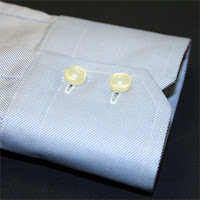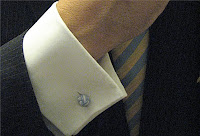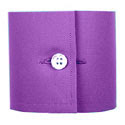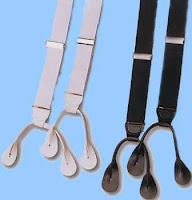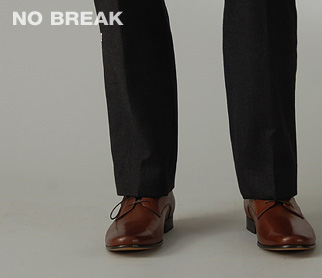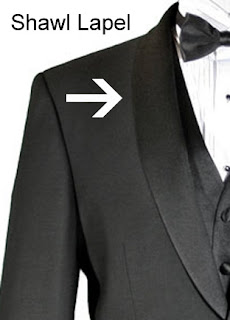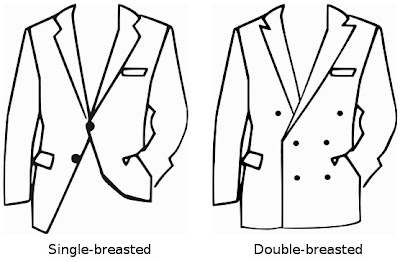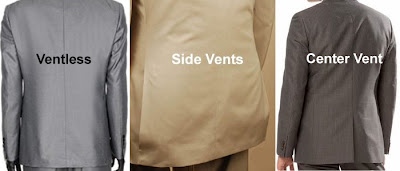Again, you may think that obtaining a dress shirt is simple, and it can be, but there are different styles and options that you need to know. Firstly, it's very important for you to know your size. No, this doesn't mean "oh I'm a large" or "I wear a medium shirt"...these aren't t-shirts we're talking about here. Dress shirts are sized like this: 16-16.5;33/34 representing your neck size and sleeve length, respectively. It is important to ensure both these numbers are proportionate to your actual neck size and sleeve length, otherwise your shirt won't fit properly (remember the importance we stressed about FIT) and you'll either look like an amateur (if the shirt is too small) or sloppy (if the shirt is too big). Starting from top to bottom, let's cover the different styles of collars and cuffs available.
Collars: there's not much difference in collar styles; most notable differences will come in the length of the point or spread of the two sides.
Now, most of you are probably only aware of one style of collar. By far the most common and widespread is the standard point collar, which is found on almost 99.9% of dress shirts you can by at retail stores. While there's nothing wrong with the point collar, aesthetically it's probably the most proportionate and even, it's commonality is what drives me bonkers. Additionally, point collars don't serve the skinny tie trend very well. If you know nothing of style, the point collar will be your best and safest bet as it treats all neck sizes equally and will accomodate different tie knots the same; it's also important to point out that point collars can be of the standard variety or button down variety. Point collars are a quintissential American style, and have been for many years though recently, they have taken more of an "every day guy" type back seat to the other styles; that is to say point collared shirts are generally purchased and worn by those on a budget and/or sartorially limited.
The second type of collar you may or may not be familiar with are the spread collars. These come in two different varieties: half spread (also referred to as quarter spread), or full spread (sometimes referred to as half spread). For the purposes of this article, we will refer to them as half spread and full spread, respectively. The appeal of these collars is they give off a more athletic look, where the points are spread further apart. These collars generally accomodate thick tie knots the best; a la full windsors. In the later seasons of HBO's comedy/drama 'Entourage', super agent Ari Gold (played by Jeremy Piven) can be seen sporting numerous half and full spread collared dress shirts (it's important to distinguish however, that his shirts are probably bespoke and made to his specifications as spread collared shirts are not too common). Spread collars are derived from British style, and are featured on more European designer labels. Lately, they have become more and more popular among the business elite; CEO's, hedge fund managers, attorneys, etc as well as those more stylishly inclined. Spread collars are my preffered shirt style.
Below: full spread (left) half spread (right) courtesy of http://www.execshirts.com/
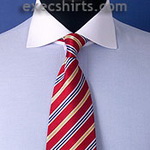

Other collar styles you should be aware of (but are less mainstream): pin collars, where the two points are "pinned together" by collar pins (either provded with the shirt or purchased separately), this style was popular in the 90's, and Mandarin collars. Mandarin collars were also popular in the 90's due to the fact that the collar didn't fold down like others and, therefore, didn't require the wearing of a tie. While the aforementioned can still be pulled off with a little creativity, I'd steer clear of the latter as much as possible, unless you want to look like a clergyman (different if you ARE a clergyman) or in a bad Jet Li movie.
Below: pin collar (left) mandarin/tab collar (right) courtesy of http://www.execshirts.com/
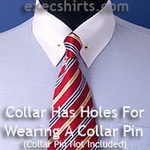

Sleeve cuffs: the cuffs on shirts come in three different styles. Barrel cuff, French cuff, and convertible cuff. They are differentiated by how the cuffs are fastened together.
Barrel cuffs are the standard found on run of the mill, retail store dress shirts. The cuffs are fastened together by buttons (generally one or two) sewn in on one side. See to the right.
French cuffs (my personal preference) have an elongated sleeve, because the cuff is essentially doubled in size. This allows for the bottom portion of the cuff to be folded up to meet the top portion. French cuffs do not have buttons, but instead are fastened by cufflinks. French cuff shirts are the perfect way to achieve that understated level of class and elegance to any suit. Sometimes you will see shirts that are French cuff are doubled/folded over, avoid these at all costs. Traditional French cuffs are like those pictured to the left; the standard barrel cuff with slits that are passed off as French cuffs are cheap imitations.
Convertible cuffs are barrel cuffs that have both buttons and slits and can be easily converted between traditional barrel cuffs and French cuffs. I would avoid these as well because it makes you look indecisive. If you prefer one type of cuff over the other, buy shirts with those cuffs. If you like both, alternate. Buy one that's barrel, one that's French, etc. I will be completely honest when I say that I HATE convertible cuffs. They should all burn in hell. You will find convertible cuffs a lot of times on those cheap tuxedo shirts you rent; do yourself a favor and skip convertible cuffs.
Ties. If you're the average man, you probably hate ties. You have no idea what tie will match what shirt (patterns especially) and I can't tell you how many guys I ran into in college that had NO idea whatsoever how to tie a tie; let's not even get started about how there are more than one type of knot. I've even heard a story about a friend of mine who had to tie several ties in advance for a friend of his in college for an out of town job interview, just so he had several options. This is unacceptable. Gentleman, TIE YOUR OWN TIES!!! For God's sake, at least learn how to tie one knot, very well. The three most common tie knots are as follows:
Full windsor: also referred to as a double windsor, this is my preference. It is the most symmetrical and gives you the perfect triangle knot look. It is also a larger knot (since more wrapping is involved) and complements spread collar dress shirts beautifully.
How to tie a full/double windsor:
Half windsor: also referred to as the single windsor, this is probably the most common tie knot. It differs itself from the full windsor in that there are less strokes and wraps involved. You still achieve the triangle knot, but when compared to it's big brother, it is increasingly asymmetrical. The half windsor is perhaps best suited (no pun intended) for shirts where the collar points are very close together. How to tie a half/single windsor:
Four-in-hand: this knot looks very similar (if almost identical) to the half windsor. It only differs itself in the steps on how it's tied. The body of the tie in a four-in-hand is wrapped twice on the same side whereas the half-windsor is wrapped only once on a single side.The same asymmetrical triangle look is achieved and again, is best for shirt collars in which the points are closer together.
How to tie a four-in hand:
Remember, the tip of your tie should hit your belt buckle. No higher, no lower. Also, take some time to adjust your knot so that it looks crisp and neat. Most people (women especially) notice the little details and can spot a sloppy tied tie from a mile away.
Shoes: now shoes are fairly simple. There are a few rules to employ when wearing a suit that applies to shoes that you should follow. Firstly, lace-up oxfords ONLY. When you're wearing a shirt and tie with a suit (presumably to work, an interview or some event that requires the aforementioned threads) the ONLY shoes acceptable are leather lace-up oxfords. Whether they're round-toe or square-toe is up to you, but I'd suggest sticking with a round-toe slim silhouette oxford with slim fit suits. Colors should be black, brown, or tan/cognac only and should match your belt. Color coordination tips: grays, charcoals and navys can be matched with any color shoe. Those are the most versatile colors for suits. Not sure what color to get? One of those will allow you ultimate versatility. I don't really need to show pictures of shoes, do I?
Wearing a suit casually? Say, with a v-neck or no tie? Feel free to spice up your shoe game with loafers or wingtips. Maybe throw in some Chuck Taylors if you dare.
Accessories: there are a few accessories you can employ to touch up your suit game.
Firstly, tie bars. Tie bars are clips (they can match your cufflinks but don't have to) that hold your tie to the button placket of your shirt. This prevents your tie from blowing astray in the wind, being dipped into soup at dinner, etc. They come in a variety of finishes (gold, silver, matte, brushed, etc) and widths to accomodate different ties and styles.
Remember, the tip of your tie should hit your belt buckle. No higher, no lower. Also, take some time to adjust your knot so that it looks crisp and neat. Most people (women especially) notice the little details and can spot a sloppy tied tie from a mile away.
Shoes: now shoes are fairly simple. There are a few rules to employ when wearing a suit that applies to shoes that you should follow. Firstly, lace-up oxfords ONLY. When you're wearing a shirt and tie with a suit (presumably to work, an interview or some event that requires the aforementioned threads) the ONLY shoes acceptable are leather lace-up oxfords. Whether they're round-toe or square-toe is up to you, but I'd suggest sticking with a round-toe slim silhouette oxford with slim fit suits. Colors should be black, brown, or tan/cognac only and should match your belt. Color coordination tips: grays, charcoals and navys can be matched with any color shoe. Those are the most versatile colors for suits. Not sure what color to get? One of those will allow you ultimate versatility. I don't really need to show pictures of shoes, do I?
Wearing a suit casually? Say, with a v-neck or no tie? Feel free to spice up your shoe game with loafers or wingtips. Maybe throw in some Chuck Taylors if you dare.
Accessories: there are a few accessories you can employ to touch up your suit game.
Firstly, tie bars. Tie bars are clips (they can match your cufflinks but don't have to) that hold your tie to the button placket of your shirt. This prevents your tie from blowing astray in the wind, being dipped into soup at dinner, etc. They come in a variety of finishes (gold, silver, matte, brushed, etc) and widths to accomodate different ties and styles.
Cufflinks: they fasten the cuffs on your French cuff shirt. Great little accessories that can be personalized to whatever your desire is and are available from pretty much every major designer. Plethora of different metal materials, finishes, and styles which allow you to dress up or dress down as you please.
Belts/suspenders: two different options to keep your pants up. Belts should be leather, with a simple buckle in brown, black or tan/congnac. Your belt should match your shoes. Suspenders can be any variety (granted you don't mix earthtone suspenders with say, a black suit) and should be worn independently. That is, wearing a belt? No suspenders. Wearing suspenders? No belt. They do NOT go together. Suspenders should be fastened with pre-sewn buttons on the inside of your pants. The clip on variety, much like clip on ties, are NOT acceptable.
So hopefully this weeks expose' has helped you readers reach your sartorial peak in becoming more of a refined gentleman. And, being as I've spent most of my day at work composing today's post, I bid you, the Style & Swag Nation adieu for now. Thanks for being part and reading! Happy weekend.

